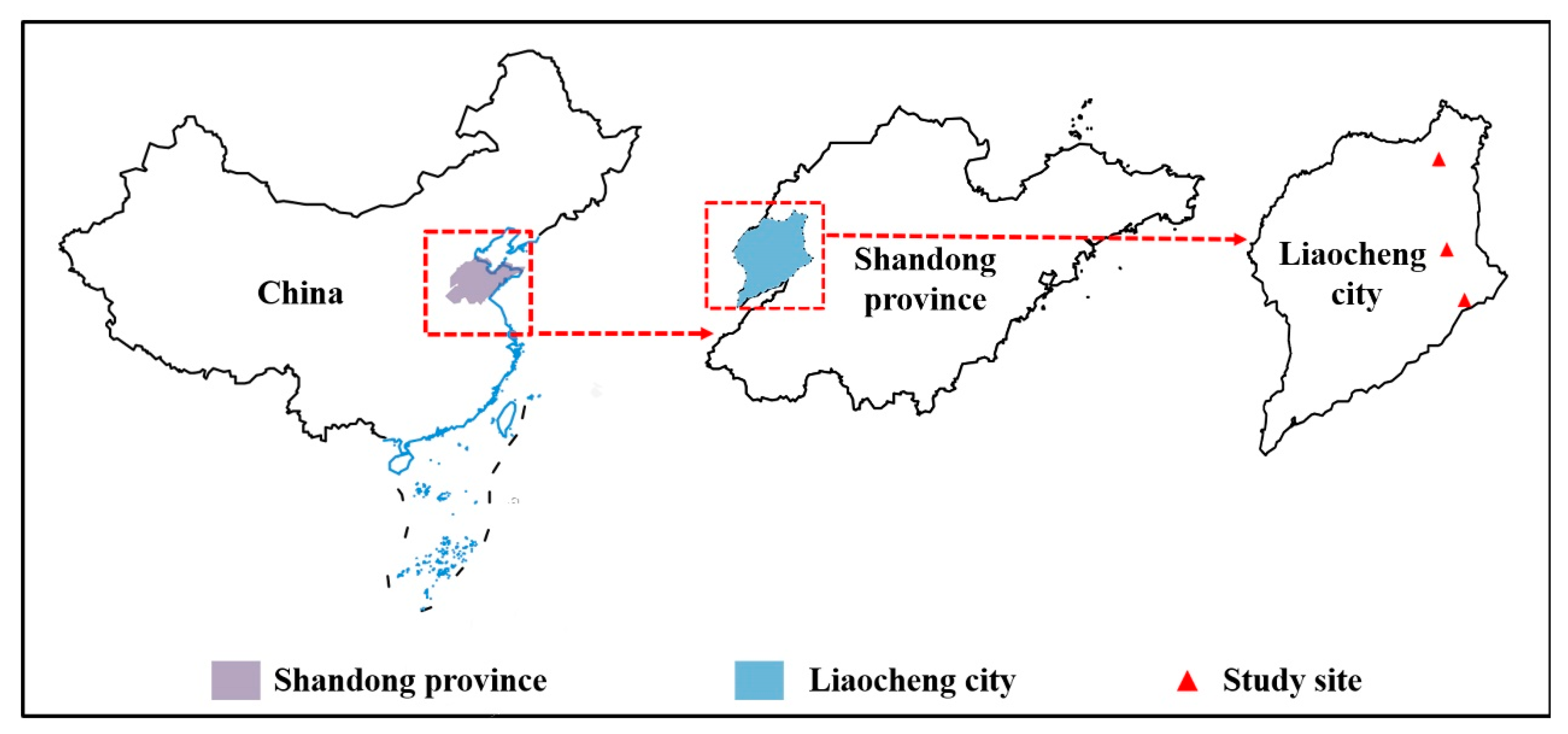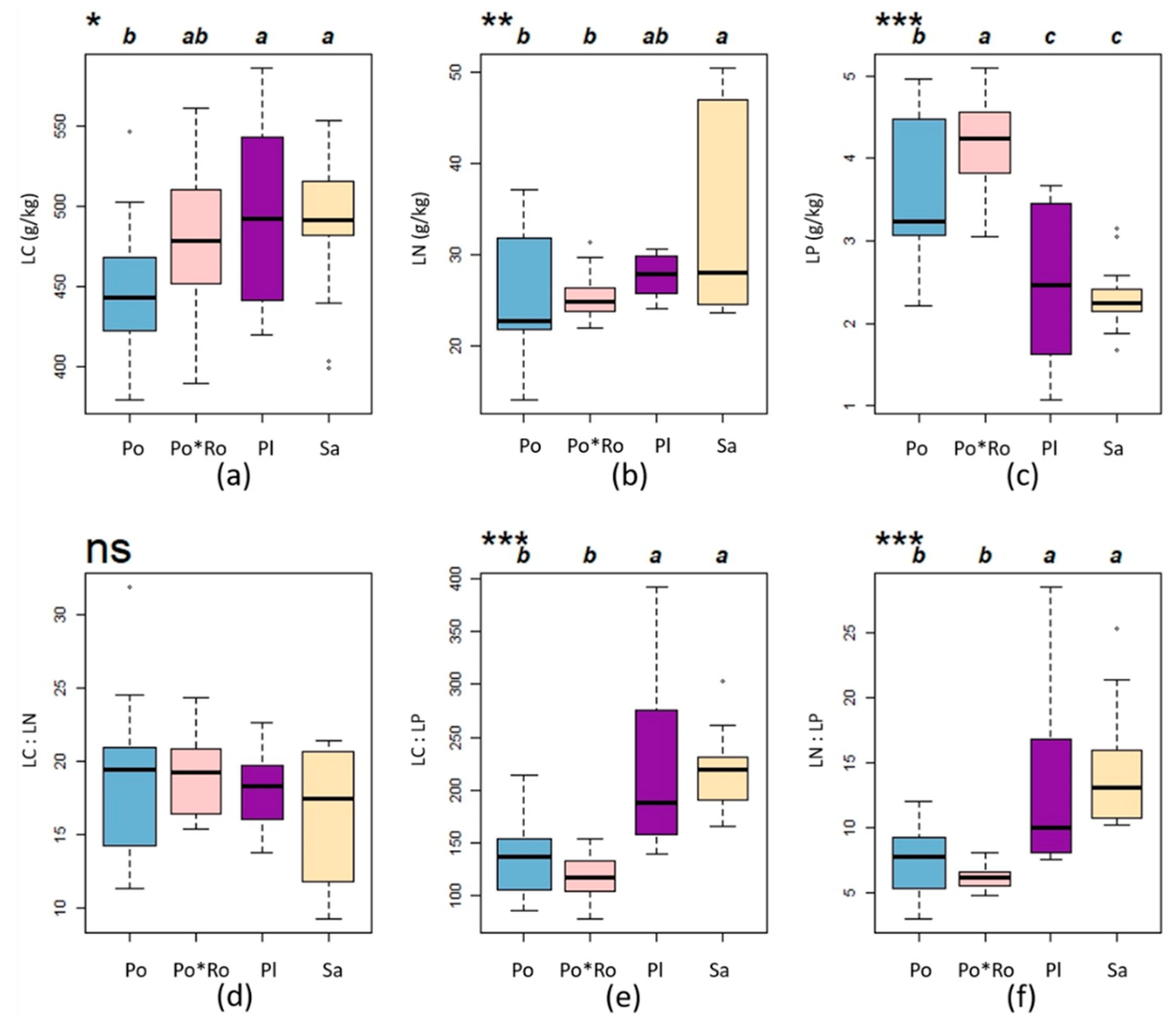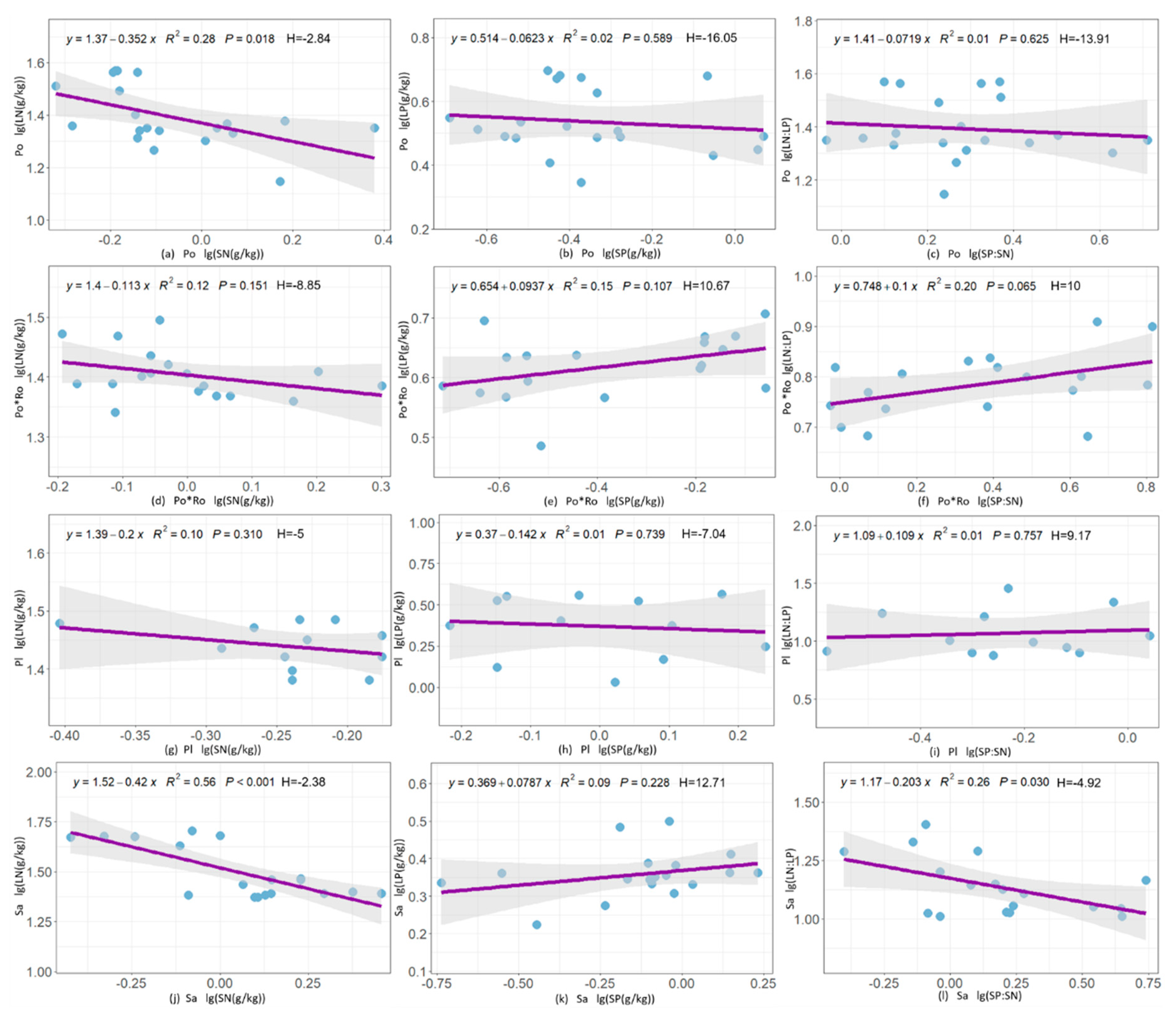Submitted:
05 July 2024
Posted:
09 July 2024
You are already at the latest version
Abstract
Keywords:
1. Introduction
2. Materials and Methods
2.1. Study Area
2.2. Sample Plot Setting
2.3. Samples Collection and Determination
2.4. Data Analysis
3. Results
3.1. C, N, P and C:N:P Ratios in Leaves
3.2. C, N, P and C:N:P Ratios in Soil
3.3. Stoichiometric Relationships within the Leaf–Soil Continuum
3.4. Homeostasis Analysis of Leaf N, P and N:P Ratios
4. Discussion
4.1. C, N, P and C:N:P Ratios of Leaf and Soil among Different Forest Stand Types
4.2. Correlation Analysis of C, N, P and C:N:P Ratios in Leaf–Soil of Four Forest Stand Types
4.3. Evaluation of Plant Homeostasis
5. Conclusion
Author Contributions
Funding
Acknowledgments
Conflicts of Interest
References
- Elser, J.; Hamilton, A. Stoichiometry and the New Biology: The Future Is Now. Plos Biol 2007, 5, 181-183, https://doi.org/10.1371/journal.pbio.0050181. [CrossRef]
- Robert W Sterner; James J Elser. Ecological Stoichiometry: The Biology of Elements from Molecules to the Biosphere. Princeton: Princeton University Press 2003, https://doi.org/10.1515/9781400885695. [CrossRef]
- Wenxuan Han; Jingyun Fang; Dali Guo; Zhang, Y. Leaf nitrogen and phosphorus stoichiometry across 753 terrestrial plant species in China. New Phytol 2005, 168, 377-385, https://doi.org/10.1111/j.1469-8137.2005.01530.x. [CrossRef]
- J Sardans; Ivan A Janssens; Philippe Ciais; Michael Obersteiner; J Peñuelas. Recent advances and future research in ecological stoichiometry. Perspect Plant Ecol 2021, 50, 125611, https://doi.org/10.1016/j.ppees.2021.125611. [CrossRef]
- John D. Schade; Marcia Kyle; S. E. Hobbie; W. F. Fagan; J. J. Elser. Stoichiometric tracking of soil nutrients by a desert insect herbivore. Ecol Lett 2003, 6, 96-101, https://doi.org/10.1046/j.1461-0248.2003.00409.x. [CrossRef]
- Zhang, C.; Zeng, F.; Zeng, Z.; Du, H.; Zhang, L.; Su, L.; Lu, M.; Zhang, H. Carbon, Nitrogen and Phosphorus Stoichiometry and Its Influencing Factors in Karst Primary Forest. Forests 2022, 13, 1990, 10.3390/f13121990. [CrossRef]
- Peter B Reich; Mark G. Tjoelker; Jose-Luis Machado; Jacek Oleksyn. Universal scaling of respiratory metabolism, size and nitrogen in plants. Nature 2006, 439, 457-461, https://doi.org/10.1038/nature04282. [CrossRef]
- Peter B. Reich. Global biogeography of plant chemistry: filling in the blanks. New Phytol 2005, 168, 263-266, https://doi.org/10.1111/j.1469-8137.2005.01562.x. [CrossRef]
- Jack T. Tessier; Dudley J. Raynal. Use of Nitrogen to Phosphorus Ratios in Plant Tissue as an Indicator of Nutrient Limitation and Nitrogen Saturation. J. Appl Ecol 2003, 40, 523-534, https://doi.org/10.1046/j.1365-2664.2003.00820.x. [CrossRef]
- L. A. Schreeg; L. S. Santiago; S. J. Wright; B. L. Turner. Stem, root, and older leaf N:P ratios are more responsive indicators of soil nutrient availability than new foliage. Ecology 2014, 95, 2062-2068, https://doi.org/10.1890/13-1671.1. [CrossRef]
- Hessen, D. O.; Gren, G. R. I.; Anderson, T. R.; Elser, J. J.; De Ruiter, P. C. CARBON SEQUESTRATION IN ECOSYSTEMS: THE ROLE OF STOICHIOMETRY. Ecology 2004, 85, 1179-1192, https://doi.org/10.1890/02-0251. [CrossRef]
- V. Minden; M. Kleyer. Internal and external regulation of plant organ stoichiometry. Plant Biology (Stuttgart, Germany) 2014, 16, 897-907, https://doi.org/10.1111/plb.12155. [CrossRef]
- Tingting Zhang; Wenyao Liu; Junbiao Huang; Tao Hu; Dandan, T.; Quan, C. Characteristics of plant ecological stoichiometry homeostasis. Guihaia 2019, 39, 701-712, https://doi.org/10.11931/guihaia.gxzw201805050. [CrossRef]
- Yinghan Zhao; Tian Li; Jingkuan Sun; Junhan Liu; Zhanyong Fu. Study on ecological stoichiometry homeostasis characteristics of different halophytes in the Yellow River Delta. Land Degrad Dev 2024, 35, 784-797, https://doi.org/10.1002/ldr.4952. [CrossRef]
- Tinghui Hu; Kangning Xiong; Yanghua Yu; Jun Wang; Yawei Wu. Ecological stoichiometry and homeostasis characteristics of plant-litter-soil system with vegetation restoration of the karst desertification control. Front. Plant Sci. 2023, 14, https://doi.org/10.3389/fpls.2023.1224691. [CrossRef]
- Ifigenia Urbina; Oriol Grau; Jordi Sardans; Josep M. Ninot; Josep Peñuelas. Encroachment of shrubs into subalpine grasslands in the Pyrenees changes the plant-soil stoichiometry spectrum. Plant Soil 2020, 448, 37-53, https://doi.org/10.1007/s11104-019-04420-3. [CrossRef]
- Jianguo Liu; Xiaohua Gou; Fang Wang; Jie Liu; Fen Zhang. Seasonal patterns in the leaf C:N:P stoichiometry of four conifers on the northeastern Tibetan Plateau. Glob. Ecol. Conserv. 2023, 47, e2632, https://doi.org/10.1016/j.gecco.2023.e02632. [CrossRef]
- Lei Wang; Muhammad Arif; Jie Zheng; Changxiao Li. Patterns and drivers of plant carbon, nitrogen, and phosphorus stoichiometry in a novel riparian ecosystem. Front. Plant Sci. 2024, 15, https://doi.org/10.3389/fpls.2024.1354222. [CrossRef]
- Jonas Persson; Patrick Fink; Akira Goto; James M. Hood; Jayne Jonas; Satoshi Kato. To be or not to be what you eat: regulation of stoichiometric homeostasis among autotrophs and heterotrophs. Oikos 2010, 119, 741-751, https://doi.org/10.1111/j.1600-0706.2009.18545.x. [CrossRef]
- Yanli Zhang; Miao Liu; Li Han; Jinhu Yang; Xinyao Zhao; Jiahui Qu; Lijun Li; Yunlong Bai; Dong Yan; Guannan Hou. Spatial Distribution Characteristics of Soil C:N:P:K Eco-Stoichiometry of Farmland and Grassland in the Agro-Pastoral Ecotone in Inner Mongolia, China. Agronomy 2024, 14, 346, https://doi.org/10.20944/preprints202312.2080.v1. [CrossRef]
- James J. Elser; William F. Fagan; Robert F. Denno; Dean R. Dobberfuhl; Ayoola Folarin; Andrea Huberty; Sebastian Interlandi; Susan S. Kilham; Edward Mccauley; Kimberly L Schulz; Evan H. Siemann; ROobert W. Sterner. Nutritional constraints in terrestrial and freshwater food webs. Nature 2000, 408, 578-580, https://doi.org/10.1038/35046058. [CrossRef]
- Jiaxiang Li; Wenting Xu; Gaoming Xiong; Yang Wang; Changming Zhao. Leaf nitrogen and phosphorus concentration and the empirical regulations in dominant woody plants of shrublands across southern China. Chin J Plant Ecol 2017, 41, 31-42, https://doi.org/10.17521/cjpe.2016.0251. [CrossRef]
- Yuzhuo Hao; Lei Zhou; Hui Wu; Shuli Wang. Comparison of ecological stoichiometric characteristics of leaf-litter-soil in four types of Fraxinus mandshurica plantations. J. Nanjing Forestry Uni. 2019, 43, 101-108, https://doi.org/10.3969/j.issn.1000-2006.201806021. [CrossRef]
- Fang Zhao; Dongdong Li; Feng Jiao; Jing Yao; Haotian Du. The Latitudinal Patterns of Leaf and Soil C:N:P Stoichiometry in the Loess Plateau of China. Front. Plant Sci. 2019, 10, 10.3389/fpls.2019.00085. [CrossRef]
- Xiaolin Feng; Yuyang Yan; Xinran Zhang; Chutian Zhang; Zengchao Geng; Feinan Hu; Chenyang Xu. Temporal and Spatial Variations of Soil Organic Carbon and the Influencing Factors in Shanxi Province in Recent 30 Years. Environ Sci 2024, https://doi.org/10.13227/j.hjkx.202311169. [CrossRef]
- Javier De La Casa; Jordi Sardans; Marta Galindo; Josep Peñuelas. Stoichiometry of litter decomposition under the effects of climate change and nutrient enrichment: A meta-analysis. Plant Soil 2024, https://doi.org/10.1007/s11104-024-06718-3. [CrossRef]
- Luca Bragazza; Mario Fontana; Thomas Guillaume; Kate M. Scow; Sokrat Sinaj. Nutrient stoichiometry of a plant-microbe-soil system in response to cover crop species and soil type. Plant Soil 2021, 461, 517-531, https://doi.org/10.1007/s11104-021-04853-9. [CrossRef]
- J. Sardans; A. Rivas-Ubach; J. Peñuelas. The C:N:P stoichiometry of organisms and ecosystems in a changing world: A review and perspectives. Perspect Plant Ecol 2012, 14, 33-47, https://doi.org/10.1016/j.ppees.2011.08.002. [CrossRef]
- Hanqin Tian; Guangsheng Chen; Chi Zhang; Jerry M Melillo; Charles A S Hall. Pattern and variation of C:N:P ratios in China′s soils: a synthesis of observational data. Biogeochemistry 2010, 98, 139-151, https://doi.org/10.1007/s10533-009-9382-0. [CrossRef]
- Ford Ballantyne IV; Duncan NL Menge; Annette Ostling; Parviez Hosseini. Nutrient recycling affects autotroph and ecosystem stoichiometry. The American Naturalist 2008, 171, 511-523, https://doi.org/10.1086/528967. [CrossRef]
- Qijuan Hu; Maoyin Sheng; Yixin Bai; Yin Jie; Hailong Xiao. Response of C, N, and P stoichiometry characteristics of Broussonetia papyrifera to altitude gradients and soil nutrients in the karst rocky ecosystem, SW China. Plant Soil 2022, 475, 123-136, https://doi.org/10.1007/s11104-020-04742-7. [CrossRef]
- Shaojie Zheng; Xiaofei Cha; Lijuan Sun; Huanxian Guo; Qize Zhao; Xinglan Wei; Yuanyou Wang; Qiong Dong. Study on the Characteristics of Soil Ecological Stoichiometry and Non-Structural Carbon in Different Forest Ages of Fraxinus malacophylla. J. Nucl. Agric. Sci. 2024, 38, 364-373, https://doi.org/10.11869/j.issn.1000-8551.2024.02.0364. [CrossRef]
- Lei JING; Yan ZHOU; Cai LV; Junru ZHAO; Guangchun LEI. Characterization of the soil and leaf C, N, and P stoichiometry of poplar plantations of three different stand ages in Dongting Lake wetland, China. Perspect Plant Ecol 2018, 38, 6530-6538, 10.5846/stxb201803300691. [CrossRef]
- Marie Spohn. Element cycling as driven by stoichiometric homeostasis of soil microorganisms. Basic Appl Ecol 2016, 17, 471-478, https://doi.org/10.1016/j.baae.2016.05.003. [CrossRef]
- W X Han; J Y Fang; P B Reich; F Ian Woodward; Z H Wang. Biogeography and variability of eleven mineral elements in plant leaves across gradients of climate, soil and plant functional type in China. Ecol Lett 2011, 14, 788-796, https://doi.org/10.1111/j.1461-0248.2011.01641.x. [CrossRef]




| Forest community type |
Latitude and longitude |
Average tree height (m) |
Average DBH (cm) |
Herb Coverage (%) |
MAP (mm) |
|---|---|---|---|---|---|
| Po | 36°47′ N;116°3′~116°4′E | 20.85 ± 7.54 | 23.71 ± 11.22 | 57.8 ± 19.77 | 602.92 ± 0.62 |
| Po*Ro | 36°47′N;116°4′E | 20.37 ± 10.18 | 24.48 ± 13.62 | 61.44 ± 27.72 | 602.94 ± 0.31 |
| Pl | 36°24′~36°47′N;116°16′~116°4′E | 15.8 ± 10.18 | 15.78 ± 1.42 | 17.08 ± 15.77 | 618.51 ± 16.08 |
| Sa | 36°13′~36°24′N;116°15′~11628′E | 18.22 ± 3.24 | 19.22 ± 30.6 | 72.78 ± 26.63 | 637.05 ± 0.16 |
| forest stand types | SC (g/kg) | SN (g/kg) | SP (g/kg) | SC:SN | SC:SP | SN:SP |
|---|---|---|---|---|---|---|
| Po | 4.68 ± 3.50 a | 0.93 ± 0.45 ab | 0.50 ± 0.28 b | 4.67 ± 2.15 ab | 10.17 ± 7.52 a | 2.12 ±1.05 a |
| Po*Ro | 5.28 ± 1.33 a | 1.03 ± 0.35 ab | 0.48 ± 0.24 b | 5.29 ± 0.87 a | 14.61 ± 0.87 a | 2.84 ±1.82 a |
| Pl | 1.78 ± 0.78 b | 0.58 ± 0.08 b | 1.04 ± 0.35 a | 3.21 ± 1.59 b | 1.86 ± 0.97 b | 0.62 ± 0.24 b |
| Sa | 6.58 ± 2.70 a | 1.29 ± 0.65 a | 0.85 ± 0.39 a | 5.56 ± 1.76 a | 10.00 ± 7.39 a | 1.94 ± 1.49 a |
Disclaimer/Publisher’s Note: The statements, opinions and data contained in all publications are solely those of the individual author(s) and contributor(s) and not of MDPI and/or the editor(s). MDPI and/or the editor(s) disclaim responsibility for any injury to people or property resulting from any ideas, methods, instructions or products referred to in the content. |
© 2024 by the authors. Licensee MDPI, Basel, Switzerland. This article is an open access article distributed under the terms and conditions of the Creative Commons Attribution (CC BY) license (http://creativecommons.org/licenses/by/4.0/).




